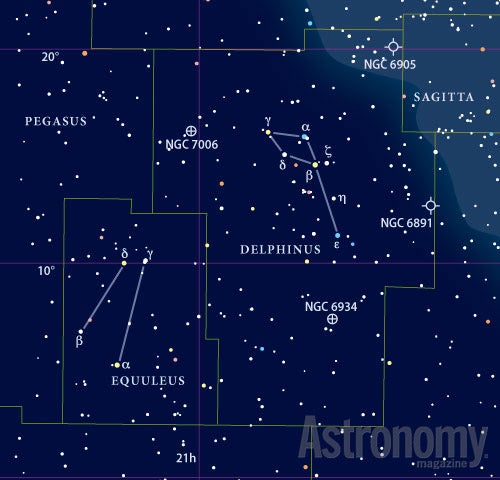Targets for August 27–September 3, 2015
Small telescope:
Double stars Gamma (γ) Delphini and Epsilon (ε) Equulei
Large telescope:
Globular cluster NGC 6934
Large telescope:
The Cheeseburger Nebula (NGC 7026)
This week’s small-telescope targets are double stars in a pair of often overlooked constellations. Gamma (γ) Delphini is first.
You’ll find this nice double star 15° northeast of magnitude 2.7 Tarazed (Gamma Aquilae). The yellow and white stars have a subtle color contrast I find quite pleasing. Their magnitudes are 4.3 and 5.2, respectively. Because the separation measures 10″, a 4-inch telescope at a magnification of 100 will split this pair easily.
My second double star selection is Epsilon (ε) Equulei (also known as 1 Equulei). You’ll find this star 4.3° west-southwest of magnitude 3.9 Kitalpha (Alpha [α] Equulei). Its separation, 10.7″, is slightly wider than that of Gamma Delphini.
This easily split binary yields a magnitude 6.0 primary that shines yellow-white and a magnitude 7.1 secondary with an off-white hue.
A distant globular
This week’s first large-scope object is globular cluster NGC 6934 in Delphinus. Amateur astronomers also know it as Caldwell 47. It shines at magnitude 8.9 and measures 5.9′ across.
This object floats 3.9° south of magnitude 4.0 Epsilon Delphini. Because it lies some 55,000 light-years away, you’ll have trouble resolving individual stars through a small telescope.
Through a 10-inch scope, however, you’ll start to pick out stars in the halo region, but not near the core. You’d need a much larger scope for that. NGC 6934 is bright, so crank the magnification above 300. The magnitude 9.2 star GSC 522:2249 sits 2′ west of the cluster’s center.
Swiss or aged cheddar?
This week’s second large-telescope target is the Cheeseburger Nebula, also known as planetary nebula NGC 7026 in Cygnus. It glows at magnitude 10.9. To find it, look 12′ north-northwest of the magnitude 4.6 star 63 Cygni.
NGC 7026 is a tiny planetary nebula, but its surface brightness is high, so you can spot it even through a 4-inch telescope. The problem with that size instrument, however, is identifying the planetary from surrounding stars. Alternately moving an Oxygen-III filter in front of your eyepiece will make the stars fainter but leave the planetary undimmed. Really, though, this is a large-telescope object.
Through a 12-inch or larger instrument, you’ll see two nebulous lobes. Because of its shape, some amateurs call NGC 7026 the Tiny Dumbbell Nebula, a reference to M27 in Vulpecula. The tiny version’s long axis spans 21″.
Under a magnification less than 200, the lobes will appear to touch. The eastern lobe glows slightly brighter.
American amateur astronomer Jay McNeil (who later found McNeil’s Nebula in M78) dubbed this object the Cheeseburger Nebula in 1999 because that’s what it looked like to him. And he doesn’t even live in Wisconsin.
Expand your observing at Astronomy.com
StarDome
Check out Astronomy.com’s interactive StarDome to see an accurate map of your sky. This tool will help you locate this week’s targets.
The Sky this Week
Get a daily digest of celestial events coming soon to a sky near you.
Observing Talk
After you listen to the podcast and try to find the objects, be sure to share your observing experience with us by leaving a comment at the blog or in the Reader Forums.











